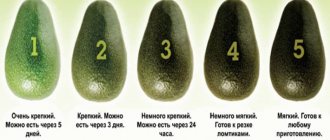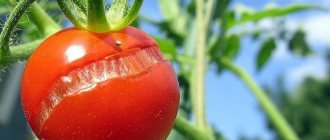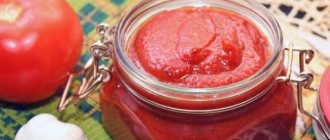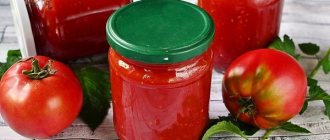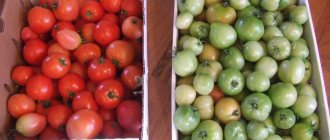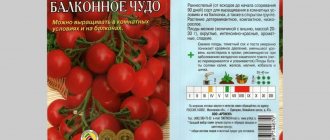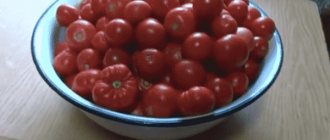In the middle zone, almost half of the tomatoes do not have time to ripen before the onset of cold weather. And sometimes green fruits have to be picked in the summer to save them from diseases or pests. In order for unripe tomatoes to become tasty and sweet, they are ripened after being removed from the bush, i.e. brought to a state of ripeness. It is convenient to do this right in the apartment. You just need to know which tomatoes are capable of ripening on their own, and what conditions need to be created for them.
What tomatoes can be ripened
In order for tomatoes to be tasty after ripening, they should not be picked from the bush too early. This can be done only after they reach the stage of milky ripeness. As the name suggests, at this stage the green fruits lighten and become whitish. Their size already corresponds to the varietal characteristics, and after ripening they also acquire normal taste and color. Moreover, their seeds can be used for sowing. Another sign that tomatoes are ready for harvesting is that they become shiny, almost glossy.
In some varieties, the fruits acquire a whitish color very early, already at the ovary stage. In this case, you need to focus on their size. There is one reliable way to check the readiness of tomatoes for ripening, but to do this you will have to cut them. After which, of course, it will no longer be possible to ripen them. However, you can still do this with a couple of tomatoes to see if similar fruits can be picked. The bottom line is that milk tomatoes have seed chambers completely filled with mucus, while completely green tomatoes have empty spaces inside.
The next stage is brown ripeness, also called blanzhevoy. At this stage, the tomatoes are a quarter of the color yellowish-brown or flesh-colored. If you cut them, the flesh inside will be pink. This is not surprising, because the ripening of tomatoes begins with their core. So the skin may still be brown-green, but inside the reddening process is already in full swing. Sometimes the pink stage of ripeness is distinguished separately, when pink sides already appear on the tomatoes. However, it is usually classified as brown.
Will these tomatoes be as tasty?
Will tomatoes ripened indoors taste as good as if they were ripened on the plant? It seems to be a matter of opinion. A store-bought tomato will never compare to one grown at home, but somehow a properly ripened tomato in your home should compare in texture and taste to tomatoes ripened in your garden. Even if the tomatoes lose some quality, it is much better to let them ripen indoors than to lose the entire crop.
Collect green tomatoes in full size, slightly soft, preferably a little colored
When to pick tomatoes for ripening
Steady cool weather, and even more so the threat of frost, is a signal for gardeners that it’s time to harvest tomatoes. Cold itself has a bad effect on fruit ripening, and together with dampness it can cause an outbreak of late blight. This insidious disease can destroy tomatoes in just one night. So it’s better not to take risks and pick fruits if the average daily temperature stays around +15°, and at night drops to +8°. You should not wait for it to drop to +4°, as the tomatoes will then lose their ability to ripen.
Tomatoes should be harvested in dry weather so that there is no moisture on them. It is better to do this in the morning, but only after the dew has dried.
If numerous signs of late blight appear on the bushes, then they no longer look at the weather, but hastily remove the surviving fruits. Even if tomatoes from diseased plants look healthy, it is still better to process them. They may be affected by the disease, and when ripened they will begin to turn black. Usually, such suspicious fruits are dipped in a weak, warm solution of potassium permanganate (about 40°), after which they are rinsed in clean water and wiped with a cloth. In this case, the solution should not be too strong and hot, otherwise the fruits will be damaged and will not be able to ripen.
What not to do while tomatoes are ripening
Water generously. Tomatoes do not like sudden changes in humidity. Do not let the soil dry out and then water it generously. This causes the fruits to crack. It is better to mulch the soil under the tomatoes with hay. Under mulch, moisture is retained much longer, the earth does not crack from the heat and does not become crusty.
There are also special bacteria in hay that prevent the late blight pathogen from multiplying. During fruiting, it is better not to water tomatoes.
Feed with nitrogen. From the second half of summer, tomatoes cannot be fertilized with nitrogen in any form. Mullein, chicken droppings, infusion of green mass, and mineral nitrogen fertilizers are not used.
Tomatoes will intensively grow green mass, not fruits. And such fertilizing also worsens the taste of the fruit. Even if your climate allows you to grow tomatoes until late autumn, still apply only potassium-phosphorus fertilizers.
How to pick tomatoes for ripening
You need to carefully remove tomatoes from the bush so as not to scratch or bruise them, otherwise they will quickly deteriorate when ripening. For the same reason, you should not throw them in a basket or bucket. It is better to carefully place them in prepared containers. It is also advisable to place paper or fabric on the bottom for even greater protection from damage.
It is generally recommended to leave short stems on tomatoes, especially large ones, as this reduces the likelihood of them rotting. In addition, in some varieties they can only be torn off together with the pulp, and this will certainly lead to spoilage of the fruit. So you shouldn’t specifically remove the “tails,” at least if they are difficult to separate from the tomato. If the stalk falls off on its own, and a strong cork layer remains underneath it, then there is nothing to worry about.
However, stalks also have disadvantages - tomatoes with “tails” take longer to ripen. In addition, sharp petioles can damage the delicate skin of neighboring fruits, and they will begin to rot. To avoid this, tomatoes with stalks must be placed in a special way or each tomato must be wrapped in paper. This is not entirely convenient, so sometimes it is easier to remove the stalks.
Answers to frequently asked questions
Is it possible to ripen frozen fruits?
If the summer resident did not have time to collect the tomatoes and they get frozen, they are quickly damaged and are not suitable for storage. Therefore, it is necessary to try to pick vegetables in a timely manner before the first night frosts.
Is it possible to store tomatoes in paper boxes?
Wooden or plastic boxes are used to store tomatoes. Paper products become wet and damaged. This is especially suitable for cases where tomatoes are stored in humid conditions.
How to speed up the ripening of tomatoes on hanging bushes?
For such cases, you need to dig up the tops along with a lump of soil. The plant will receive nutrients and saturate the fruits with vitamins.
Under what conditions are tomatoes ripened?
The warmer the room, the faster the tomatoes ripen. However, this does not mean that the hotter the better. The optimal temperature for ripening is 20-25°. If conditions differ from those recommended, the following occurs:
• At 28-30°, tomatoes become too soft, while near the stalks they remain unripe - yellowish and hard.
• At temperatures above 30°, tomatoes quickly turn red, but this is only an external effect. In fact, the fruits are not yet ripe, they do not have enough sugars, and therefore they are sour. Small tomatoes in such heat wither due to intense evaporation of moisture.
• At 10-15°, tomatoes ripen very slowly. Sometimes this is beneficial if you want to get ripe tomatoes for the New Year. However, at low temperatures more rotten fruit appears.
• At temperatures below 10° the process slows down so much that many tomatoes rot faster than they can ripen. If milk fruits can still be stored at 8-10°, then brown fruits need a temperature of 4-6°.
Tomatoes can be ripened both in the light and in the dark, but it is advisable to avoid direct sunlight. Under the sun, the fruits may overheat and begin to rot, or due to the high temperature, their flesh will soften and acquire a porridge-like consistency. Also, due to the heat, a lot of moisture evaporates from tomatoes, and they can shrink. This is especially true for green fruits.
Tomatoes can be kept not in direct sunlight, but simply in a bright room. Then they will turn red faster than when ripening in the dark. They will also be more vibrant and beautiful. However, in the light, the skin of tomatoes becomes harsh, while in the dark it is softer.
Humidity also matters. The optimal indicator is 80-85%. If the room is too dry, the tomatoes wither and shrivel; if it is damp, they rot. It is especially important to maintain the recommended humidity when ripening tomatoes in cool conditions.
The place where the tomatoes are stored should be regularly ventilated. This is necessary not only to get rid of high humidity. When fruits ripen, they consume oxygen and release carbon dioxide. Without access to fresh air, there is too much carbon dioxide, and, on the contrary, there is not enough oxygen. Under such conditions, ripening slows down or stops altogether.
Features of tomato harvesting
Based on personal experience and mistakes made, I made a few rules for myself:
- Tomatoes picked under the bright sun wither faster and soon lose their presentation. I harvest every 5-7 days depending on the weather.
- In open ground, it is advisable to remove all fruits when the temperature at night begins to drop to +5 °C. On the bush I leave only small things on the upper flowering branches. If I have time, I wrap each crown of my head with covering material. If it is possible to provide temporary shelter from cold and rain, you can leave the tomatoes to ripen on the branches.
- I even collect whole fruits from diseased bushes separately. Late blight is insidious and does not appear on fruits immediately. Tomatoes with stains from condensation or insect excrement should not be removed for long-term storage either.
- I cut off part of the crop for long-term ripening with tassels, and immediately place them in cardboard boxes in only one layer (in winter I pick up the containers from the nearest store; milk and baby food are packaged in it).
- I put the fruits in shallow buckets so as not to damage the ripest ones.
If a tomato breaks off a sepal, I don’t deliberately tear it off. The fruits of many large varieties fall off on their own.
How to speed up the ripening of picked tomatoes
If there is ethylene in the air, then tomatoes ripen 1.5 times faster. Ethylene is easy to obtain at home. It is released by ripening tomatoes, apples and especially bananas. All of the above vegetables and fruits can be added to green tomatoes to speed up the process. Just don’t use overripe fruits, as they can start to rot at any moment, and no one needs such neighbors. Ethylene is released in sufficient quantities by tomatoes as soon as they begin to turn red, or by bananas with still green tips.
Fast ripening
A small harvest can be ripened right in the apartment. Typically, gardeners place green tomatoes on trays and window sills or lay them out in several layers in boxes or cardboard boxes. In warm weather, the fruits ripen quickly, so they are sorted every two days: the ripened ones are taken and the rotten ones are removed.
The harvest will ripen faster if you add red apples to it. Two or three pieces are enough. Ripe tomatoes and bananas are also suitable.
Often, gardeners prefer to ripen fruits on hanging bushes, for which a well-ventilated room is allocated. In this case, dense placement of bushes is unacceptable, as otherwise the fruits may rot. To many gardeners, fruits that ripened on bushes seem juicier and more aromatic than those that ripened in boxes.
Where to ripen tomatoes and how to stack them
Tomatoes can be ripened in any place with suitable temperature, lighting and humidity. This could be a newspaper under the bed, the top of a closet, a sofa niche for linen, or a furniture drawer. It is very convenient to arrange the tomatoes in cardboard boxes and place them in the hallway or entryway. A small amount of tomatoes can be placed in a paper bag, which must be opened from time to time for ventilation. A traditional windowsill is not the best option, as it will expose the fruits to direct sunlight.
Before storing for ripening, it is advisable to sort the tomatoes by degree of ripeness and size. Then the individual piles will ripen evenly. To ensure normal ventilation between the fruits, it is recommended to lay them in 1-2 layers, but green ones can be laid in 3 layers at first. To be on the safe side, you can also leave a small distance between the tomatoes. It is advisable to wrap fruits from bushes infected with late blight in paper and place them so that they do not touch each other.
If the indoor air is dry, it makes sense to cover the tomatoes with a cloth to retain moisture. It is also useful to place a newspaper on top of the reddening tomatoes - ethylene will accumulate under it, and other fruits will ripen faster.
How to stop ripening
Some gardeners, on the contrary, want to extend the ripening period of tomatoes until autumn. This will allow you to enjoy ripe fruits even at the beginning of winter. To stop ripening, vegetables are stored in a cool place with a temperature of no more than 15 degrees Celsius. The ideal storage space is a cellar, basement, attic. The tomatoes are placed in boxes or crates, covered loosely with lids and several ventilation holes are made in it. The boxes or boxes are put into the basement, where the vegetables will be stored for several weeks.
Attention! It is necessary to monitor the humidity in the room so that it is not high and the fruits remain dry.
Instead of boxes, you can put the tomatoes in plastic bags and hang them from the ceiling of the cellar. A low temperature will stop ripening, however, it does not contribute to its complete cessation; it proceeds with low intensity.
Sometimes tomato bushes are dug out of a greenhouse or open ground directly with the rhizome and suspended by the root from the ceiling, without separating the tomatoes from the branches. The tomatoes will sing right on the bush, because the stem continues to supply the fruit with the necessary nutrients for some time.
If the technology for collecting and storing fruits is violated, the harvest can be completely ruined. Ripening is considered a natural procedure and does not harm the quality of tomatoes, but only improves the taste characteristics.
Best Ways to Store Green Tomatoes to Turn Red
Options depend on the amount of crop harvested and specific conditions. In private houses and dachas, it is more convenient to use a veranda or outbuildings: a summer kitchen, etc. In an ordinary city apartment, loggias, balconies, and window sills are used. The main condition is efficient ventilation and free access to the fruits for their regular inspection and rejection of spoiled specimens.
How to properly store green tomatoes so that they turn red and last longer? Experienced gardeners recommend adhering to the following rules:
- for long-term storage, a thin layer of wax must be applied to the skin of the fruit;
- cleansing of late blight spores on the surface of vegetables is carried out with hot water (60 degrees) - the tomatoes are dipped in the liquid for three minutes, then they are dried and thoroughly wiped with a dry rag;
- placement in boxes is carried out in layers, no more than three rows - many layers will interfere with regular inspection and separation from the bulk of defective specimens with signs of fungal infection;
- preservation in boxes requires appropriate layout - the stalks should face in opposite directions, this approach will help reduce the risk of damage to the skin of the fruit by sharp petioles;
- Vegetables must be inspected every 72 hours.
Important! The simplest method for accelerated ripening of green fruits is the use of injections of vodka into the area of the stalk, 0.2 ml of the drink. This method does not affect the quality characteristics of vegetables; seeds from “drunk” tomatoes germinate on a par with regular ones.
On shelves
Many owners have shelves in their pantries and cellars on which unripe vegetables can be placed. If this method is suitable, then lay out the tomatoes in 1-2 layers, with the stalks facing the ceiling. The optimal conditions for the technique are a dry and well-ventilated room.
To speed up the ripening process, place several pieces of ripe apples on the shelves or cover each layer of vegetables with hay. The average culture ripening time is from 7 to 10 days.
Important! If you violate the temperature regime and increase it above 28 degrees, then the vegetables will quickly lose their elasticity and become tasteless.
Ripening after storage on shelves
In packages
The method depends on the capabilities:
- In apartment conditions, tomatoes are stored in paper bags, and before storing, the fruits are wiped with a cloth soaked in regular vodka. This will reduce the risk of spreading infection and increase storage time. If the temperature on the balcony is constantly from +18 to 20 degrees, then the vegetables will turn reddish in 2 weeks. At temperatures below 15 degrees, crop ripening should be expected within one calendar month.
- In the basement or cellar, the use of paper or plastic bags is allowed - tying them is strictly prohibited. Air must flow freely to the fruits, and the bags must be suspended. Due to low temperatures, ripening will take place more slowly.
Important! Hermetically sealed bags of tomatoes will create a greenhouse effect and rapid rotting. Free air flow is a prerequisite to prevent the formation of rot.
When using paper bags, each fruit must be intact, and the upper layers must not injure the lower ones. Throughout the ripening period, it is necessary to monitor the processes - reddened vegetables are raised up, green ones are lowered down.
